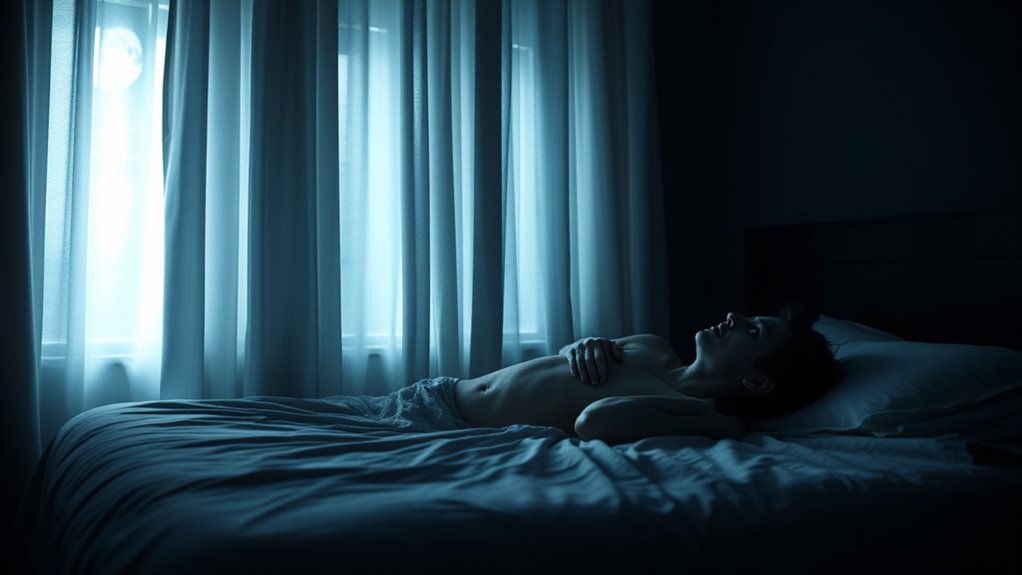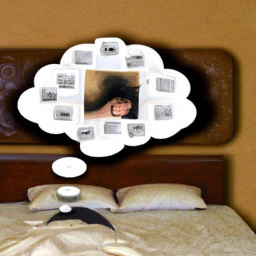Sleep paralysis is a temporary state where you wake up or fall asleep but can’t move or speak, often accompanied by vivid hallucinations or a feeling of an ominous presence. It happens when your mind wakes but your body remains in atonia, and it can be triggered by stress, irregular sleep, or nightmares. Many find it frightening, but understanding its connection to dreams and sleep cycles can help ease fear. If you keep exploring, you’ll find ways to manage and reduce these episodes effectively.
Key Takeaways
- Sleep paralysis is a temporary inability to move or speak during waking or falling asleep, often with vivid hallucinations.
- It occurs when the mind wakes from REM sleep while the body remains in atonia.
- Episodes can be triggered by stress, sleep deprivation, irregular sleep schedules, or attempts at lucid dreaming.
- It is generally harmless, lasting from seconds to minutes, and can be managed by focusing on calm breathing.
- Understanding sleep cycles and maintaining good sleep hygiene can help prevent and reduce episodes.

Sleep paralysis is a frightening experience that occurs when you wake up or fall asleep and find yourself unable to move or speak, often accompanied by vivid hallucinations. During these episodes, your mind wakes up while your body remains in a state of atonia, leaving you trapped in a liminal space between sleep and wakefulness. It can be terrifying, especially when you sense an ominous presence or see strange figures, making it feel like a nightmare come to life. These episodes usually last from a few seconds to a couple of minutes but can leave a lasting impression. Understanding what triggers sleep paralysis can help you manage or even reduce its occurrence.
One common thread linked to sleep paralysis is its association with vivid dreams and nightmares. Often, these episodes occur during times of stress, irregular sleep schedules, or sleep deprivation, which can increase the likelihood of experiencing disturbing dreams. Nightmares can sometimes bleed into sleep paralysis episodes, making the hallucinations more intense and frightening. Conversely, some people report experiencing a sense of control during these episodes, which can lead to lucid dreaming. Lucid dreaming occurs when you become aware that you’re dreaming and can sometimes influence the dream’s outcome. *Curiously*, some individuals intentionally try to induce lucid dreams, which involves a delicate balance of consciousness within the dream state. This heightened awareness can sometimes trigger sleep paralysis, especially if you’re trying to control your dreams or become aware of the dream state intentionally. Additionally, understanding the sleep-wake cycle can help you better grasp why these episodes happen and how to prevent them.
If you’re prone to nightmares or trying to practice lucid dreaming, it’s essential to be aware of how these experiences interact with sleep paralysis. Training yourself to recognize the signs of sleep paralysis can help you reduce panic when it happens. For example, focusing on slow, controlled breathing or attempting to move small muscles can sometimes break the paralysis faster. Many who experience sleep paralysis find that trying to stay calm and remind themselves that they are safe helps diminish fear and anxiety. Maintaining a regular sleep schedule, avoiding sleep deprivation, and managing stress are practical steps to reduce the frequency of episodes linked to nightmares or lucid dreaming efforts.
While sleep paralysis can be unsettling, it’s generally harmless and temporary. Understanding its connection to dreams, nightmares, and lucid dreaming can empower you to approach these episodes with less fear. Recognizing when you’re in sleep paralysis and knowing how to respond can make a significant difference, helping you regain control and eventually prevent future episodes. With patience and proper sleep hygiene, you can minimize the impact of sleep paralysis and improve your overall sleep quality.
Frequently Asked Questions
Can Sleep Paralysis Be a Sign of a Serious Medical Condition?
Sleep paralysis can sometimes indicate underlying causes or neurological factors, but it’s usually not a sign of a serious medical condition. If you experience it frequently or alongside other symptoms like severe anxiety, it’s wise to consult a healthcare professional. While most cases are harmless and linked to disrupted sleep cycles or stress, understanding your specific situation helps rule out any potential underlying issues.
How Long Does Sleep Paralysis Typically Last?
Sleep paralysis episodes typically last from a few seconds up to around two minutes, though they can sometimes extend longer. Your sleep duration and episode frequency can influence how often you experience sleep paralysis. Usually, these episodes end quickly, but if they happen frequently or last longer, it might be worth discussing with a healthcare professional. Understanding your sleep patterns can help manage or reduce the episodes effectively.
Is Sleep Paralysis More Common in Certain Age Groups?
Sure, because who doesn’t enjoy a spooky sleep experience at every life stage? Sleep paralysis tends to be more common during certain age groups, particularly teens and young adults, thanks to developmental stages and stress. As you age, its prevalence usually declines, but it can still surprise you at any age. So, whether you’re a teenager or a seasoned adult, beware—your sleep might just turn into a nightly horror show.
Are There Effective Treatments or Remedies for Sleep Paralysis?
You can manage sleep paralysis through improved sleep hygiene, like maintaining a consistent sleep schedule and reducing stress. While medication options are available, they’re usually reserved for severe cases and should be prescribed by a healthcare professional. Focus on creating a relaxing bedtime routine, avoiding caffeine before bed, and managing anxiety. These strategies often help lessen episodes, making sleep more restful and reducing the likelihood of paralysis occurring.
Can Lifestyle Changes Reduce the Frequency of Sleep Paralysis Episodes?
Yes, lifestyle changes can help reduce sleep paralysis episodes. You can improve your sleep hygiene by maintaining a consistent sleep schedule, creating a relaxing bedtime routine, and avoiding screens before bed. Managing stress through meditation, deep breathing, or exercise also plays an essential role. By prioritizing sleep hygiene and practicing stress management, you actively lower the chances of experiencing sleep paralysis, leading to more restful and uninterrupted nights.
Conclusion
Sleep paralysis can feel frightening, but understanding it can bring relief. Remember, you’re not alone, and these episodes are temporary. By learning about sleep paralysis, you empower yourself to face fears with newfound confidence. Don’t dwell on dread—distract, breathe, and remind yourself it’s just a moment. With awareness and calmness, you can conquer the confusion and reclaim peaceful, restful nights. Embrace education, ease your fears, and enjoy endless, effortless sleep.









